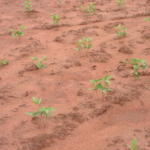


Cornell University
11/2007—11/2008
This one-year project provided practical outcomes from agroecosystem research carried out with World Neighbors Bolivia, a McKnight CCRP project grantee in the Andean region. During the research phase we developed a quantitative analysis based on crop nutrient balances1 of farms managed by smallholders in northern Potosí, Bolivia. This nutrient balance modeling then provided important messages that we designed into innovative training products: computer tools, workshop activities, and web-based text/visual presentations. For this research to have impact at the local level, we are also communicating these messages in an executive summary format (policy brief) for policymakers.Many of the messages and training tools transcend the project area in highland Bolivia and are suitable for other projects in the CCRP Andean Community of Practice. We also wish to support others in the region in carrying out research relevant to soils and systems approaches to cropping systems. In developing models of nutrient flows in Andean mixed crop-livestock farming systems, we have contributed foundations for future modeling efforts as well as identified knowledge gaps, principally in the area of soil erosion.
The project provided the following outcomes to the CCRP Andean Community of Practice projects, using the CCRP e-list, direct delivery to NGOs, community of practice conferences, and the McKnight CCRP website.A computer-based nutrient budgeting tool that allows calculations of nutrient balances reflecting fertility practices and research results in use by Andean smallholder farmers. This will allow NGO staff in conjunction with farmers to develop training messages about trends in soil fertility based on actual local data about fertility management (posted below).Computer-based and physical versions of a farmer nutrient management game. This game allows farmers, development professionals and students to see the consequences of farm management decisions and environmental factors such as crop rotation, harvest, or erosion on the flows of major crop nutrients. The game links these flows to measures of livelihood such as health, livestock, and financial assets. (posting on the website forthcoming).A policy brief written to help local municipal and national policymakers in the Bolivian context understand the central messages that emerge from our analysis of smallholder farmer management in Northern Potosí. (forthcoming).A computer-based dynamic simulation model that underlies other project outcomes and will be provided to interested project participants for further development of models on farm management. (forthcoming)Training materials and other resources provided to the Andean Community of Practice listserv:a. A training guide on the cycling of the major crop nutrients (nitrogen, phosphorus, potassium) in crops and soil.b. Basic model data from legume experiments that allows prediction of impacts from legume biomass and nitrogen fixation.c. Linking the McKnight Andean Community of Practice to resources such as short-term predictions of El Niño/La Niña, books, and other relevant research results.1Balances are calculations of the how nutrient inputs and exports due to flows like manure application, crop harvest, and erosion affect the stocks of nitrogen, phosphorus and potassium in farmers’ fields.
